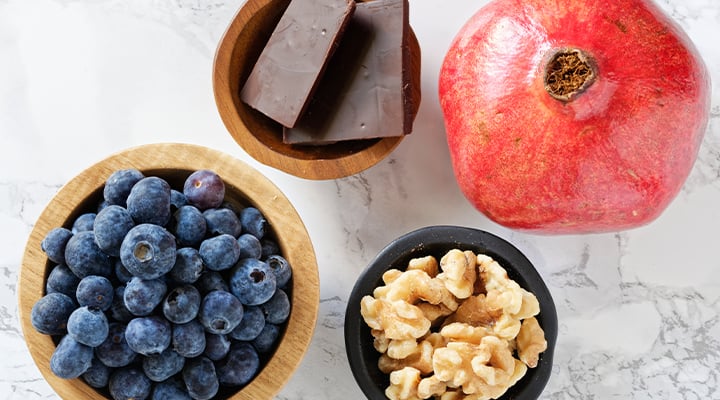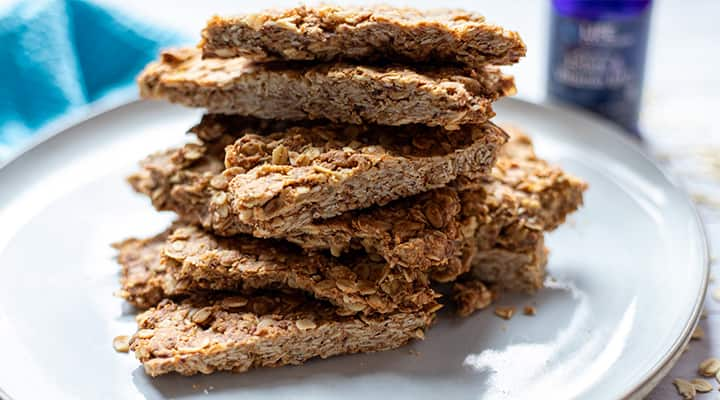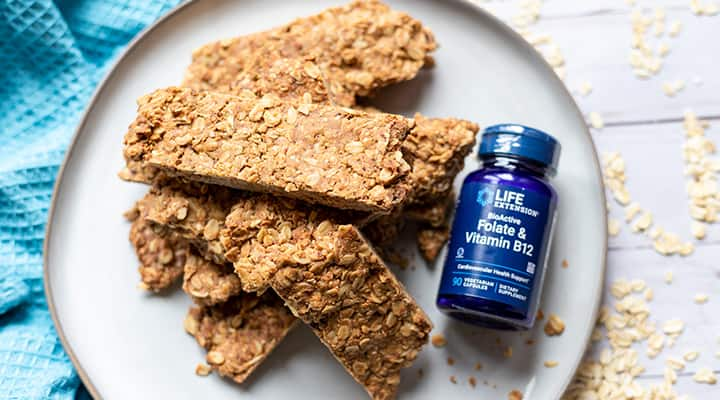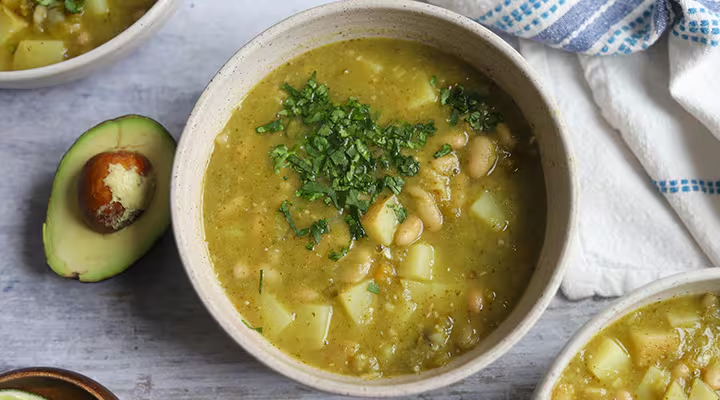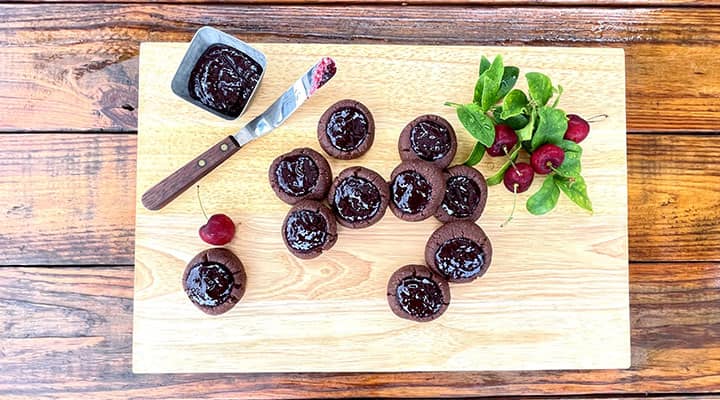
8 Best Gluten-Free Snacks Ideas (+ Granola Bar Recipe)
Published: September 2022
Gluten-free is a major diet buzz word these days. It’s all over restaurant menus, on products in grocery stores, and on social media feeds and videos. But what’s the deal with gluten free? And who can benefit from this diet?
Let’s explore what this term means, plus the best snacks for people avoiding gluten in their diets—including my tasty granola bar recipe, which can be whipped together quicky, using a few basic healthy pantry staples.
What does gluten-free mean?
When using the term “gluten-free” to describe a food, it means it is completely free from gluten, a protein found in grains like wheat, barley and rye. Simply put, no food or drink is gluten-free if it includes wheat—which could be anything from bread, pasta, crackers and pretzels to beer and malt beverages. If a person is described as “gluten free,” it means they follow a diet that does not include gluten.
Thankfully, there are plenty of gluten-free foods and snacks, such as crackers, pretzels and other crunchy products made with alternative ingredients, to satisfy the taste buds and appetites of gluten-free individuals. You can get apple chips, veggie chips, cauliflower crackers, pretzels made with corn starch and potato starch instead of wheat, and almond flour crackers and cookies, among other gluten-free snacks. So gluten-free doesn’t mean you have to go hungry.
Is gluten-free always healthy? Pros & cons
A gluten-free diet can be healthy if the diet is filled with whole foods. The key to a healthy gluten-free diet is choosing vegetables, fruits, meats and cheeses over convenience items like gluten-free snacks, breads and pastas. Keeping your diet varied in nutrients is important. The pros of a gluten-free diet are debatable unless you are avoiding gluten for a specific health reason.
The jury is still out on whether this diet is useful for someone who is not avoiding gluten for a specific health reason. On the one hand, eating gluten-free often shifts you away from eating processed foods, which contain added oils, sugars and sodium along with gluten. And avoiding gluten can help you maintain a keto diet. But a major con of a gluten-free diet is that these foods are often low in fiber, which supports digestive health, and other nutrients that breads and pastas are fortified with.
What basic foods are gluten-free?
Many foods are “accidentally” gluten free. Fruits, vegetables, beans and legumes, meats and cheeses are all gluten-free. These are also some of the most healthy whole foods you can eat. (Potato chips are also gluten free, but they aren’t in that healthy category, unfortunately.)
Some foods are gluten-free but are prepared in a facility with foods containing gluten. This presents a risk of cross-contamination. If you are concerned with cross-contamination, it is essential that you read labels, especially on foods that you would expect to be gluten-free, like those potato chips. Make sure you buy certified gluten-free snacks and recipe ingredients.
8 most popular gluten-free snacks to fight back your cravings
Trying to avoid gluten, but feeling hungry? Here are some gluten-free snacks you can make at home to keep you going:
1. Sliced apples and peanut butter
Apple slices smothered in peanut butter are a quick and satisfying snack.
2. Hummus and veggie sticks
Protein-rich hummus on celery, carrots or pepper slices is a no-cook snack that is both nutritious and delicious.
3. Berries and nuts
A bowl of berries and a handful of almonds is another great grab-and-go snack.
4. Yogurt, fruit and granola
A cup of Greek yogurt (or vegan yogurt) with a handful of blueberries and homemade granola is a great midday treat—or breakfast.
5. Celery with peanut butter and raisins
“Ants on a log” is an old school snack that is yummy and good for you.
6. Rice cakes with peanut butter or almond butter
Sometimes you just crave something crunchy, and rice cakes are a low-calorie snack that really satisfies.
7. Crispy baked chickpeas
Protein-packed chickpeas can be seasoned and then baked to produce a crunchy, satisfying snack.
8. Granola bars or energy bites
Oats are a great way to get some energy! Mixed with nut butters and seeds, they make great bars or paleo-friendly, no-bake energy bites for an on-the-go snack.
Granola Bar: A homemade gluten-free recipe
Granola bars are a delicious and easy way to refuel during the day. A homemade granola bar has much less sugar and more proteins and healthy fats than store-bought bars. They are cheap and easy to make, and can be modified to fit your taste.
What is a granola bar?
These fiber-rich snack bars are made by mixing oats with nuts, seeds and other ingredients that make them stick together. Then they are baked until crispy and cut into bars. The bar shape makes them a healthy snack when you are on the go.
Explore Our Best Digestive Health Supplements
How to make a gluten-free granola bar at home
Making a gluten-free snack bar at home is easy. Just mix gluten-free oats with your choice of nut or seed butter, a little coconut oil, maple syrup and dates. Then bake it until it is crispy. You will be shocked at how easy it is! Be aware, these bars are not uniform in shape and will crumble more than a store-bought bar. But their texture is pleasant, and their taste is kid-approved!
Ingredients
There are surprisingly few ingredients in this homemade bar, all of which are easy to find (and easily substituted if not available).
- 2 cups gluten-free oats
- 3/4 cup peanut butter or nut/seed butter of choice
- 2 tbsp pure maple syrup or honey
- 1/4 tsp sea salt
- 1 tsp cinnamon
- 3 tbsp hemp seeds or sesame or flax seeds
- 1/2 cup walnuts or cashews or pistachios
- 1 cup pitted dates
- 2 tsp coconut oil
Preparation
- Preheat oven to 350 degrees.
- Pulse walnuts and dates in a blender or food processor with coconut oil until the mix is sticky and there are no large pieces of nuts or dates.
- Add oats, maple syrup, peanut butter, sea salt, cinnamon, hemp seeds, and date and walnut mixture to a large bowl. Mix until well combined with a spoon or your hands. The mixture will be very sticky.
- Line a baking pan with parchment paper, then press mixture into pan. Press firmly until the mixture is flat and there are no holes.
- Bake in oven for 20-25 minutes, checking for doneness since ovens vary. It should be golden brown and firm to the touch when finished.
- Let the granola cool completely, then remove carefully with the parchment paper and cut into bars. Since these are homemade, there will be some crumbling, and bars may not be uniform shapes. Aim for 12 bars.
Nutritional Values
Calories: 251 kcal
Carbohydrates: 25 g
Fiber: 4 g
Sugar: 12 g
Protein: 8 g
Fat: 15 g
Saturated Fat: 3 g
Polyunsaturated Fat: 6 g
Monounsaturated Fat: 5 g
Sodium: 53 mg
Potassium: 249 mg
Vitamin A: 22 IU
Calcium: 35 mg
Iron: 2 mg
All nutritional information is based on third-party calculations and is only an estimate. Each recipe and nutritional value will vary depending on the brands you use, measuring methods and portion sizes.
Tips for success
For a successful baking experience, I have a few tips:
- Mixing the dough with your hands will ensure that the mix is truly incorporated, much more than with using a spoon.
- When adding the mixed dough to the pan, be sure to press very firmly with the tips of your fingers to make sure it is packed well. You can use an additional piece of parchment paper to flatten the dough if you do not like using your hands.
- It is essential to cool the pan completely before removing the granola to cut into bars. If the bars break while cutting, just remember they are homemade and enjoy the delicious snacks you made regardless of their shapes.
- Feel free to experiment with your favorite ingredients and mix-ins! Freeze-dried fruits and chocolate chips may make these snack bars more kid-friendly, or try almond butter and dark chocolate.
Do I get enough vitamin B12 from a gluten-free diet?
Many studies show that people on a gluten-free diet can be deficient in certain vitamins and minerals. This is especially true of those who have been gluten free long term and those who are newly gluten-free. These folks may have been improperly absorbing nutrients for some time.
People who are both gluten-free and vegan are most vulnerable to deficiency in B12, which is essential for brain health and function, energy metabolism and the production of red blood cells.
Folate and vitamin B12 supplements
To fill any nutritional gaps in your diet, consider taking a folate and vitamin B12 supplement. As someone who eats a vegan diet, I take a daily B12 supplement for my health. Vitamin B has been shown to encourage healthy organ function and cognitive health, promote cellular energy and support already-healthy blood sugar. And when folate and B12 are combined, they have even more benefits, supporting heart health, brain health and a healthy GI tract.
Eating gluten-free is a lot easier today than it was a decade ago, but your nutritional balance might still be lacking. Life Extension’s supplement quizzes may be able to help you identify any needs and fill them, so you can feel your best, even if you are eating at a more limited table.
References
- Vici G, et al. “Gluten free diet and nutrient deficiencies: A review.” Clin Nutr. December 2016. https://pubmed.ncbi.nlm.nih.gov/27211234/
- Wieser H, et al. “Food Safety and Cross-Contamination of Gluten-Free Products: A Narrative Review.” Nutrients. June 2021. https://www.ncbi.nlm.nih.gov/pmc/articles/PMC8308338/
- “Gluten-Free Diet: Is It Right for Me?” Johns Hopkins Medicine. https://www.hopkinsmedicine.org/health/conditions-and-diseases/celiac-disease/what-is-a-glutenfree-diet
Like what you read?
Please subscribe to get email updates on this blog.


